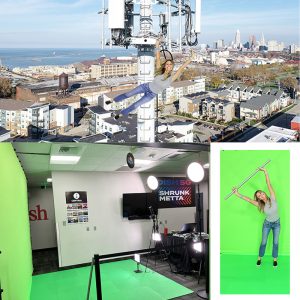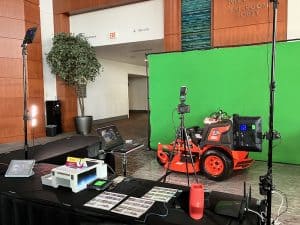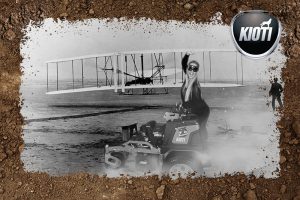How to Create the Perfect Green Screen Photo Booth (Part 1: Selecting a chromakey background)
Creating the perfect green screen photo booth is difficult. When you Google suggestions about “how to do green screen photos”, what pops up are suggestions and “rules” that don’t fit a green screen photo booth. First, the authors say, keep subjects at least 6′ off the green screen background. Next most important: use an even light on the green screen and on the subject — if possible, they suggest, use three point background lighting. (Three point background lighting uses two lights off to the side of the background, shining on the background, and one shining from the back onto the subject.) Last, they say, location is important! A room only lit by your photography lights is best. Oh, and use a big screen. All of those suggestions are spot on — if you’re in a studio. But what about when you are setting up on a convention floor? What happens when your entire space is 8′ X 8′ — how is the subject going to be 6′ off the background? If they’re 6′ off the background they are 2′ from your camera. Hmmm.
First, some basics. Green screen photo booths come in two main types: An “open air green screen photo booth” uses a point and shoot camera, ring light, and a basic fixed or enclosed setup. Typically, a “photo technician” helps the participant take their photo, but they aren’t photographers. Or, there’s the “open air” photo booth, which is a fancy way of saying a traditional photo background and camera. The camera is typically run by a photographer. Open air booths often use either studio lights or a pop of on-camera flash. Every green screen photo booth company has their individual preferences about what makes the best booth — and we are no exception. However, we don’t handle enclosed booths at all. We’re photographers. We believe to create the best green screen photo booths you need the best photographers. A digital countdown on an iPad followed by “SMILE” written on the screen just doesn’t cut it for us.

We do, however, provide open air green screen photo booths from 8′ wide to 24′ wide. In general, a 10′ – 12′ background works best in most green screen photo booth situations. Second, we tend to use lights — a lot of lights — and how we use those lights varies based on both the screen material we’re using as the backdrop and the type of support stand. We use three different types of background materials. First, a foam backed material. Second, a heavy felt type fabric with a black backing. Last, a polyester fabric that is lighter weight and isn’t prone to wrinkles. And, we use a variety of background stands: from super heavy duty outdoor stands to lighter weight indoor models that trade durability and strength for portability.
But there’s more too choosing a background stand than even light vs. heavy weight. You have to evaluate how it will fit within the dedicated booth space. Will the feet stick out? Or, does it have a heavy flat plate supporting the columns — and if it does, does the background bow forward slightly? Is the bow noticeable? Is there a fix? Are you going to use background lights, supported by the background stand? Does that make the setup top heavy?
Often, we work with booth designers to determine the best background for an individual green screen photo booth shoot. In some situations, the designers may build the green screen into the booth — either by painting the back wall, or by using a fabric common in trade show and convention booths. Either way, there’s a few things to keep in mind. First, make sure the created background is tall enough. It’s a common mistake — but you need the backdrop at least 8′ tall and preferably 8.5′ tall. If participants are going to be standing on something, then the background must be even higher. Second, if the booth designer is using paint, it needs to be a flat paint. Otherwise, any lighting will reflect on the wall as a big, white blob — and make keying (the combining of the background and foreground images) more difficult.

Remember I mentioned we had three different main materials for our portable backgrounds we utilize: Foam, polyester, or the felt material? Each has advantages. The polyester material is lighter weight and easier to transport. That can be a huge advantage. But the color tends to be too bright — meaning the tone of the green is just a little off in every background we’ve purchased and evaluated. (Note: we’ve bought these backgrounds from three different suppliers.) The “over brightness” can work to your advantage: the tone eliminates the need for background lights. In fact, background lights don’t work at all with these polyester backdrops — they bounce the light too much and create too much “spill”. (Spill means the background color is reflecting onto your participant, making the key difficult.) On the flip side, the felt-type material tends to be a bit too dark in color, and requires the use of background lights. It’s heavier, and has a black backing — which means windows, the sun, or other lights that might be in back of the background won’t bleed through. Outside, that’s a huge advantage if the sun is setting directly in back of your background. Last, the foam material combines the right color green with the heavy-duty light blocking abilities of the felt, and is what most cinematographers use on set. The main problem is it’s bulky to transport, and uses grommets and bungees to attach to the background stand. Which we like. However, the foam can separate from the grommets over time and fail at exactly the wrong moment. We have — but almost never use — pop up green screens that are typically a giant oval. They’re almost never large enough for our taste, and if they are, they are hard to transport. Also, outside, they are one huge sail that is impossible to control. Last, I didn’t mention muslin backgrounds. While they are super inexpensive, they wrinkle terribly, and — in our view– never look professional.
can separate from the grommets over time and fail at exactly the wrong moment. We have — but almost never use — pop up green screens that are typically a giant oval. They’re almost never large enough for our taste, and if they are, they are hard to transport. Also, outside, they are one huge sail that is impossible to control. Last, I didn’t mention muslin backgrounds. While they are super inexpensive, they wrinkle terribly, and — in our view– never look professional.
Picking the right background material and stand type for your green screen photo booth is the first step in a successful shoot. And, yes, it’s more complicated than you might imagine. And, of course, there’s more to a great green screen photo booth than just the background. In the next post, We’ll give tips on creating the best green screen photo booth lighting.
Foam green screen background material: Chroma-key.com
